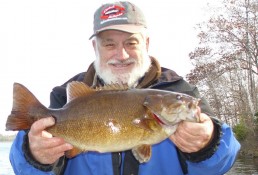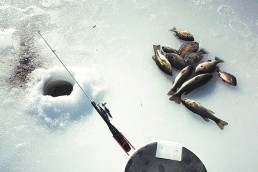Locating and Catching Ice-out Smallmouths
SHARE THIS POST
Following ice-out, locating and catching smallmouths can be difficult on many clear lakes. Natural lakes will take longer to warm but the water temperature will hold constant and not drop as severely overnight. When the water warms to about 45 degrees the pre-spawn bite can be phenomenal.
The deeper the lake the slower it warms and the longer smallmouths hold in their wintering areas. Wintering areas are typically deep rock humps, the deep edge of points, deep wood and fish cribs. These deep fish can be tough to locate even with good electronics since they hold very tight to cover. Even when you do locate them they can be tough to catch.
I have found the most aggressive smallmouths to be those relating to fish cribs. Fish cribs are common on many northern lakes and are usually put in lakes with limited or no natural structure. Most fish cribs have been permanent fixtures in lakes for many years and the longer they have been in the lake the more inviting they are to smallmouth bass. As a fish crib ages it begins to deteriorate and it becomes more fertile attracting a variety of organisms and fish.
Fish cribs are popular haunts of panfishermen, but bassers often pass them up, especially in spring. Smallmouths winter on the deep edges of fish cribs and, unlike natural structure, they tend to be more aggressive. The problem is that these fish crib-related smallmouths won’t rise up in the water column to strike a bait until the water temperature rises into the mid 40-degree Fahrenheit range. You will need to use your electronics and position your boat over the fish and vertical jig with either a hair jig or a lead head jig tipped with a minnow. I have experimented with drop shot rigs and caught a few smallmouth but I always catch more fish with jigs. Once the water warms up, drop shot rigs can out fish jigs. Before smallmouths abandon the cribs, as they enter into the pre-spawn, they will rise up into the water column to strike a bait. At this time both lipless crankbaits and suspending jerkbaits become very productive.
Once the water temperature climbs to the mid 40-degree range smallmouths begin to move out of the deep structure and move into pre-spawn staging areas. Barring a severe cold front they will remain in close proximity of these staging areas and are usually easy to locate. The advantage to staging this species on clear lakes is that they will stack up in larger schools than in stained water reservoirs. Pre-spawn smallmouths will also suspend more in clear water lakes as opposed to stained water which makes them all the easier to locate.
One word of caution, when dealing with water temperature on deep clear lakes you don’t always get what you see. Water temperatures can warm very slowly. Your locator might read 45 degrees on the surface but it is much colder on the edge of the deep hole where smallmouth are holding. As far as smallmouth are concerned it is still winter and they have no reason to leave their deep-water sanctuary.
If you are looking for the honey hole, look for a transition. The transition can be rock/sand, rock/gravel, or rock/soft bottom. After any weather change or slight drop in water temperature these transitions can be a magnet. What happens is the water temperature surrounding the rock shoreline will be a few degrees cooler. It is the transition in the water temperature that attracts the smallmouths and not the physical transition. Trust me, these are very catchable and you can have a fantastic time.
Fishing clear water always dictates using caution and taking extra precautions during the pre-spawn will mean more and bigger smallmouths. If you move in too fast you will spook the bigger fish, and while you might catch a few fish, the school will scatter. I will stop my outboard far short of the transition. Besides not spooking the big smallmouths it gives me a chance to fish the open water adjacent form the transition. Start fishing the open water with either a lipless crankbait or swim bait. After I catch a few smallmouths on either the swim bait or lipless crankbait and the action slows, I switch to a suspending jerkbait.
Are you enjoying this post?
You can be among the first to get the latest info on where to go, what to use and how to use it!
If you are looking to catch big smallmouths from clear water lakes during the pre-spawn, use suspending jerkbaits. This jerkbait pattern holds true whether you are fishing a 500-acre lake or the Great Lakes. For jerkbaits to be effective the angler needs to adapt his presentation to the mood of the smallmouths. Since fishing with suspending jerkbaits in the cold spring water can require intense concentration and persistence this pattern is not for the overzealous angler.
The average angler will typically work a jerkbait with a sharp tug, let the jerkbait suspend and after a few seconds follow up with another sharp tug. If the water temperature is on the rise and smallmouths are aggressive, this technique works great. Cool water temperatures and post-frontal conditions that are typical during the pre-spawn call for a very slow approach.
I have found the most productive method is to dead-stick the jerkbait. After you cautiously position your boat, make a long cast to the general area of the transition. Next crank the jerkbait down to its maximum depth with 10 to 15 turns of the reel handle. Stop reeling, letting the jerkbait “deadstick” or sit absolutely motionless in a suspending mode. The trick is in deciding how long to let the jerkbait sit motionless. On average I let the jerkbait suspend for at least two minutes. If I am sure smallmouths are present I will let the jerkbait suspend for as long as five minutes. As the jerkbait is suspending motionless, make sure there is sufficient slack in your line to compensate for boat movement, especially if there is a chop on the water. It is important to watch the slack line for any movement. Even the slightest movement of the line in one direction or the other can mean a smallmouth has taken the jerkbait. If you do want to move the jerkbait a bit do so by moving the rod tip and not the reel. You don’t want to jerk the bait but slowly rock it.
Deadsticking a jerkbait is not something I do on a typical pre-spawn guide trip. Not that I am trying to hold something back from my clients, but if I was to try and share this presentation most of them would think I was trying to kill some time because I knew that the fish had lockjaw. All I can say is that this is the most deadly presentation I have ever encountered for catching big pre-spawn smallmouths when fishing under post-frontal conditions.
Suspending jerkbaits are great for catching giant pre-spawn smallmouth but they are not very good search bait. For locating active pre-spawn smallmouths, it is tough to beat a lipless crankbait. Lipless crankbaits are very versatile; they can be fished shallow or deep, fast or slow. You can use a steady or stop-n-go retrieve. These baits have a fast sink rate so count down to the desired depth when fishing deeper water. Make long casts parallel to deep, sloped banks. It is important to keep the lipless crankbait in the strike zone as long as possible.
I prefer 1/4- to 1/2-ounce lipless crankbaits and use a 6-foot, 6-inch medium-action spinning rod. My spinning reel is spooled with either 8-pound fluorocarbon or monofilament line. It is important to tie directly to the split ring to produce better action. The only modification I make is to replace the front hook with a red treble hook. This tends to produce more strikes at the center of the bait for better hook ups.
Mike Mladenik has been a full-time fishing guide around Crivitz, Wis. for 30 years. He’s at home on lakes, rivers and reservoirs. Author of nine books, his biggest smallmouth is a monster of 7 pounds, 8 ounces. Contact him at bigsmallmouthbass.com.
MWO
SHARE THIS POST
Did you enjoy this post?
You can be among the first to get the latest info on where to go, what to use and how to use it!
Mike Mladenik
Mike Mladenik has been guiding for more than 30 years in Northern Wisconsin. Recognized as one of the top smallmouth bass experts in North America, he has boated 4,000+ smallmouth over 5 pounds and a few hundred over 6 pounds. Mike has authored 10 fishing books and gives seminars at sports shows across the Midwest. For more info: bigsmallmouthbass.com or 715-854-2055.



